CITRUS LEAFMINER
PHYLLOCNISTIS CITRELLA
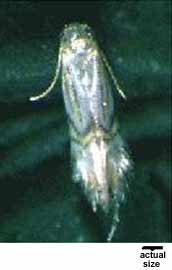
Situation: Primarily an Asian pest, citrus leafminers were first discovered in Florida in 1993. These moths rapidly became a significant problem, with infestation rates of up to 90% of orchards in some areas in Florida in the year of introduction. By 1995, the citrus leafminer was discovered in Texas, Central America, western Mexico, and several Caribbean islands. The leafminer has been found in the Imperial Valley and across the border in Mexicali, Mexico.
Damage: Larvae of citrus
leafminer form serpentine mines in leaves and fruit of citrus. Grapefruit,
lemon and lime are most susceptible to damage but the leafminer attacks
all varieties, as well as over 20 different plants belonging to the citrus
family Rutaceae. Mines are characteristized by a central line of frass
(red arrow in figure below), which can be used to separate them from mines
of the native peelminer. The citrus leafminer only infests young flushing
foliage and lays its eggs on upper and lower surfaces of leaves less than
half an inch in length. Pupation occurs in folds on the edges of leaves.
Citrus leafminer rarely attacks fruit. Leafminers have a short developmental
time andas many as 6-13 generations per year can be expected depending
on foliage flushing cycles and temperature. Infestation levels of 1-3
mines per leaf occur in Australia. In Florida, which has a much wetter
climate, infestations of 15-20 miners per leaf are common.
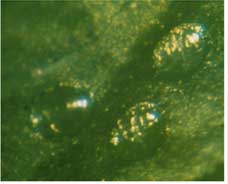

leafmine with frass lines
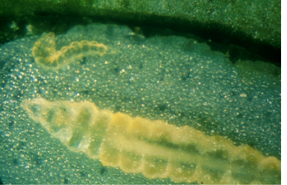
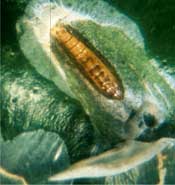
leafminer pupae
Economic Impact: Economic losses due to the citrus leafminer include 1) increased costs for protecting nursery trees and young non-bearing citrus, 2) reduced sales to home gardeners, and 3) increased orchard production costs, either directly, through the use of pesticides (largely ineffective), or indirectly, through treatments that disrupt biological control and Integrated Pest Management programs. Except on limes, the loss of yield on mature trees because of foliage damage has not been demonstrated.
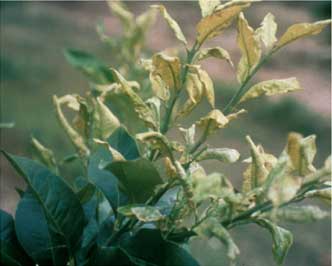
wilting after severe damage
Distribution: Citrus leafminer was relatively unknown until the mid-1970's, when in Australia, it was first noticed as a pest. It was first described in 1856 and first reported from Australia in 1918 and South Africa as early as 1908. Since it has achieved pest status, its range has rapidly expanded worldwide to include the Mediterranean, Africa, Central America and the United States.
Control: Enhancement of
natural enemies, especially parasitic wasps, is considered the most effective
means of managing infestations of the citrus leafminer on older fruit
bearing citrus. Two poly-embryonic parasitoids are considered to have
potential for effective control. 1) The encyrtid wasp, Ageniaspis
citricola, is a specific parasite and will be imported. In the
pupal stage, the wasp forms a chain of 2-7 brown cocoons. 2) The native
eulophid wasp, Cirrospilus coachellae, which attacks the citrus
peelminer, is expected to shift to the leafminer. This parasite forms
a series of 2-7 naked black pupae in the mine. Other species of native
eulophid wasps also are expected to shift to the leafminer as populations
increase.
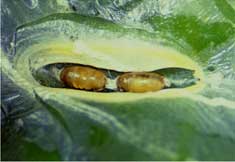
Ageniaspis pupae
Reporting Infestations: In California, if you suspect that you have a citrus leafminer infestation, please contact your local Farm Advisor or County Agricultural Commissioner's Office as soon as possible.
Original printed version prepared by the
Citrus Research Board, California Department of Food and Agriculture and
the University of California Center for Exotic
Pest Research
Web adapted by J. Jones, University of Arizona.
Questions concerning Citrus Leafminer in Arizona can be addressed to: peterell@cals.arizona.edu
Cotton Insects | Cotton Insect Pubs | Cotton Insect Data | Stickiness | Advisories | Pesticides | Photos
Home | Cotton | All Insects
document located at: http://cals.arizona.edu/crops/citrus/insects/leafminer.html
Copyright © 2001 University of Arizona,
College of Agriculture and Life Sciences
Webmaster: Al Fournier (acis@ag.arizona.edu)